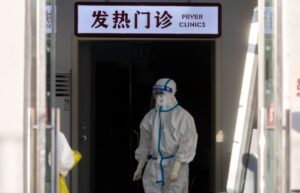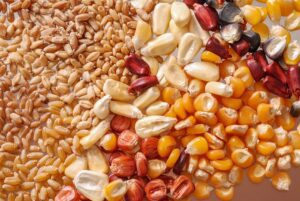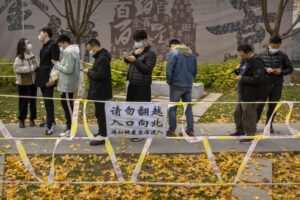
Three dry cargo vessels with corn and sunflower meal departed from Ukrainian ports on Wednesday, the Joint Coordinating Centre (JCC) has reported.
“On January 4, three ships left Ukrainian ports, carrying a total of 197,851 tonnes of grain and other food under the Black Sea Grain Initiative,” the JCC said.
Three bulk carriers – Presinge (70,514 tonnes of corn), Shen Yu 79 (64,667 tonnes of corn) and Mona KH (44,670 tonnes of corn and 18,000 sunflower meal) – are heading to China.
Seventy applications to join the Black Sea Grain Initiative have been submitted, the center said.
In addition, six ships are awaiting permission to enter the Ukrainian ports, 26 loaded dry cargo ships are waiting to sail to their destinations.
“As of January 4, the total tonnage of grain and other foodstuffs exported from the three Ukrainian ports is 16,630,516 tonnes. A total of 1,239 voyages (616 inbound and 616 outbound) have been enabled so far,” the JCC said.

China will soften restrictive measures previously imposed to combat the spread of the coronavirus in early January, the South China Morning Post reported.
China’s State Health Commission has decided to downgrade the threat of COVID 19 from the highest, “A,” to “B.” The “A” category was introduced back in 2020.
As part of this decision, from January 8, 2023, those arriving in China will not have to be sent to mandatory quarantine: this measure will remain in force only for those who have COVID 19.
At the same time, a negative test for coronavirus will be required to enter the territory of the PRC, notes Bloomberg.
In addition, according to the news agency EFE, China will also weaken control over its territory for people with coronavirus. In particular, the authorities will abandon the practice of tracking with whom a sick person had contact. They will also do away with the practice of determining how high the risk of infection is in a particular area.

Three dry cargo ships carrying corn and sunflower seeds left Ukrainian ports on Friday, the Joint Coordination Center (JCC) reported.
“Three ships left Ukrainian ports on December 2, carrying a total of 106,500 tons of grain and other agricultural products under the Black Sea Grain Initiative,” the report said.
Vessel Aspasia Luck is transporting 63 thousand tons of corn to China, Sea Inspiration is delivering 26.5 thousand tons of corn to Italy. Lady Perla dry-cargo carrier will carry 17 thousand tons of sunflower seeds to Bulgaria.
Three vessels, which passed through the sea humanitarian corridor on December 2, are also on their way to Ukrainian ports.
“As of December 2, the total tonnage of grain and other agricultural products exported from the three Ukrainian ports is 12,713,836 tons. A total of 1,031 vessels have been allowed to move so far: 515 to arrive at Ukrainian ports and 516 to leave them,” the report said.

In China, more than 31 thousand cases of infection with the coronavirus COVID-19 were detected per day, the authorities continue to tighten measures to combat the disease, the Associated Press reported on Thursday.
Over the past 24 hours, 31,444 cases of coronavirus have been detected in the country – the highest number of infections in a day since the virus was discovered in Wuhan at the end of 2019.
In the center of Henan province, the city of Zhengzhou, authorities announced tightening measures to combat the virus. In eight districts of the city, starting Thursday, for five days, people will be able to leave their homes only to buy food or receive medical care. About 6.6 million people live in these areas. The entire city will be tested daily for the virus.
In Beijing, a hospital for patients with COVID-19 opened in the exhibition center. It was also denied access to Peking University of International Studies after a case of the virus was identified there. Some shopping malls and office buildings were closed in the city.
On Monday, the city of Guangzhou imposed a lockdown on the Baiyun District, which has a population of about 3.7 million, and asked residents in parts of Shijiazhuang City not to leave their homes while mass tests for the virus were carried out in the city. About 11 million people live in Shijiazhuang.
China has a “zero tolerance” policy for COVID-19. This means that in order to limit the spread of the virus, measures such as lockdowns and mandatory quarantine for those who have come into contact with infected people are being implemented. At the same time, earlier in November, the country’s authorities announced some easing of measures, in particular, a reduction in the period of self-isolation for those arriving in the country.

Six vessels with 223.4 thousand tons of food left Ukrainian ports on Friday, having received permission from the Joint Coordination Center (JCC).
“On October 28, six ships left Ukrainian ports, they are transporting a total of 223,430 tons of grain and other agricultural products as part of the Black Sea Grain Initiative,” the SKC said in a statement.
The ship Kavo Perdika will deliver 54,160 tons of corn to Israel, the ship Zante – 47,270 tons of rapeseed to Belgium. Dry cargo ship Asl Tia transports 39 thousand tons of sunflower meal to China, dry cargo ship Super Bayern transports 33 thousand tons of corn to Italy.
In addition, two ships Rising Eagle (25 thousand tons of wheat) and Lina (25 thousand tons of corn) are sent to Egypt.
“Grain that has arrived at its destination can be processed and then transported to other countries,” the SKC explained.
It is noted that as of October 27, the total tonnage of grain and other agricultural products exported from three Ukrainian ports is 9,239,819 tons.
“At the moment, 101 vessels have been registered for verification by the SKC, another 76 have applied to join the initiative,” the message says.
As reported, in Istanbul on July 22, with the participation of the UN, Ukraine, Turkey and Russia, two documents were signed on the creation, first, for a period of 120 days, of a corridor for the export of grain from three Ukrainian ports: Chernomorskaya, Odessa and Yuzhny. Ukraine set as its goal to export 3 million tons of agricultural products per month as part of the initiative.
AGRICULTURAL PRODUCTS, BELGIUM, CHINA, dry cargo ships, EGYPT, ISRAEL, ITALY

The US authorities in the new version of the national defense strategy described Russia as an “acute threat” and China as a “major challenge” for Washington.
“Russia poses an acute threat. Even though the main challenge comes from China, recent events highlight the immediate threat from Russia,” the Pentagon said in a strategy text released Thursday.
At the same time, the Pentagon noted that, “despite the fact that divergent interests and historical mistrust between China and Russia may limit the depth of their political and military cooperation, relations between the countries continue to expand.”
The document emphasizes that Russia “continues to pose a serious threat in key areas,” including nuclear.
This includes the nuclear threat against the United States and its allies and partners, the threat of long-range cruise missiles, cyber and information operations, threats in outer space, the threat of chemical and biological weapons, and underwater warfare. strategies.
In particular, according to the document, Russia continues to modernize and expand its nuclear forces, which pose a “potential threat to the existence of the United States and its allies and partners.” The Pentagon notes that we are talking about both the 1,500 deployed Russian nuclear warheads subject to the START III treaty, and warheads for non-strategic nuclear weapons, which are not covered by any agreements. Thus, Russia remains a rival to the United States with the most combat-ready and diverse arsenal of nuclear weapons.
At the same time, the document recalls, the United States had a significant dialogue with Russia in the area of ”strategic dialogue and crisis management.” The United States and Russia also expressed their desire to extend the nuclear arms control regime beyond the scope of START III. However, the priorities of both countries differ on this issue, which indicates the need for dialogue “with regard to those goals that the US and the Russian Federation do not have the same, and the perception of those weapons systems that affect strategic stability.”
US Secretary of Defense Lloyd Austin also presented this strategy at the briefing.